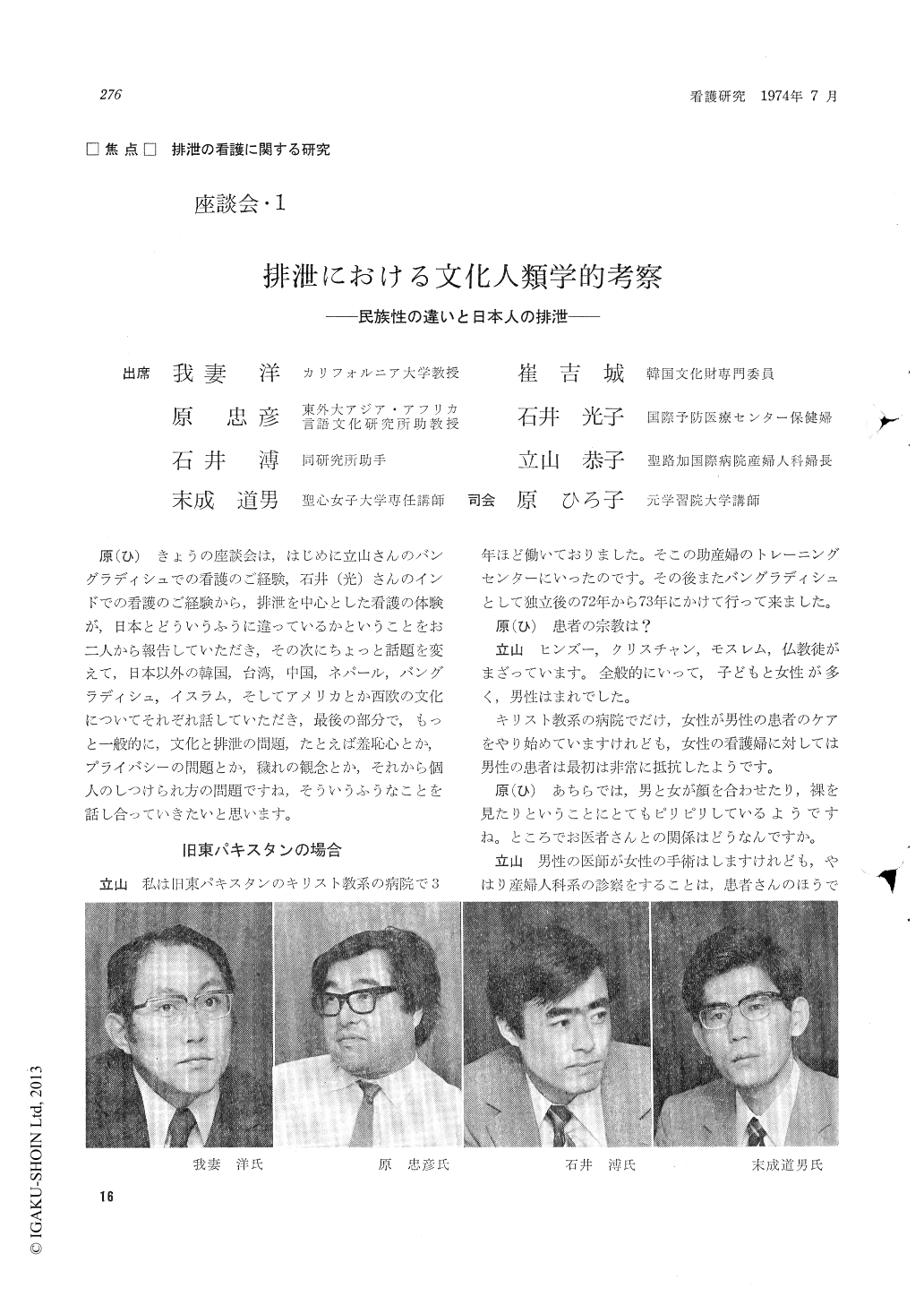16 0 0 0 OA サハリン瑞穂村の朝鮮人虐殺事件
- 著者
- 崔 吉城
- 出版者
- 国際日本文化研究センター
- 雑誌
- 世界の日本研究 = JAPANESE STUDIES AROUND THE WORLD
- 巻号頁・発行日
- vol.2005, pp.187-210, 2006-08-01
5 0 0 0 IR セマウル運動と農村振興運動
- 著者
- 崔 吉城
- 出版者
- 国立歴史民俗博物館
- 雑誌
- 国立歴史民俗博物館研究報告 (ISSN:02867400)
- 巻号頁・発行日
- no.70, pp.161-183〔含 図4p〕, 1997-01
戦後韓国社会の高度成長は朴正煕大統領の経済開発計画とセマウル運動によるものといわれている。特に農村の精神革命とも言われているセマウル運動は朴大統領自ら信念をもって一貫的に推進して成功させたという。それは彼自身農村出身であり農村近代化を推進したことであり,農民層に政治的基盤を置き,国民総和をもって長期執権のために維新憲法を発布してしまったのでセマウル運動の評価は必ずしも肯定的なものだけではない。しかし,とにかく朴大統領の政策や戦後韓国経済の高度成長を理解するためにセマウル運動の研究は必要と思う。その運動の契機や起源はまだ不明である。北朝鮮の千里馬運動とかトルコのケマルパシャ革命などと言われているが寡聞かも知れないが分析的な研究はまだない。私は朴大統領時代を経験したものの一人としてセマウル運動は戦前の日本における農村開発運動と似ていると思った。最近セマウル運動が日本植民地時代の農村振興運動と似ているという言及があったので,私はその実証的な研究をしようと考え,資料を収集した。その過程において,朴大統領が三年間小学校の教師をした学校が農村振興運動の指定学校であったことがわかった。その学校を現地調査をしたところ,老人たちによって朴氏が農村振興運動指定学校で指導していたことを確認した。一方では朝鮮総督府の宇垣一成総督の時嘱託として農村振興運動を指導した山崎延吉を知るために安城市の『山崎文庫』を尋ねて調査をした。私は本稿で植民地に因んでいる反日的な枠を無視して脱価値論的に文献研究と現地調査を合わせて日本植民地時代の農村振興運動は朴大統領のセマウル運動のモデルになっているということを明らかにしたい。Post-war Korea's progress is said to have resulted from President Park Ch'ung-hee's economic plan, and also from the Saemaul movement. In particular the latter movement ― hailed as a spiritual revolution among agricultural communities ― is said to have succeeded thanks to the efforts of President Park, who was an enthusiastic supporter. He himself had come from an agricultural village, and had urged the modernization of such communities. He had built a political base among farmers, and had promulgated a forward-looking peace-time constitution, so his interest in the Saemaul movement was more than merely perfunctory. To attain an understanding of President Park's policy and South Korea's post-war economic development it is essential, I believe, to study the Saemaul movement. Its nature and origins are still obscure. It has been compared, perhaps superficially, to North Korea's Ch'onrima movement, and to the revolution carried out by Kemal Pasha in Turkey, but thus far it has received little analysis. As one who lived through this period, it seems to me that the Saemaul movement resembled pre-war Japan's Movement to Develop Agricultural Villages. I have been gathering materials for an empirical study of the Saemaul movement, spurred on by recent claims that it shares similarities with the Movement to Encourage Agricultural Villages which was launched in Korea under Japanese colonial rule. While doing so I discovered that the primary school in which President Park had taught for three years as a young man was one which had been designated as a unit in the Movement to Encourage Agricultural Villages. On paying a visit to the area in which this school was located I was informed by elderly people that Park had led the school's participation in the movement. I also visited the Yamazaki Archives in Anjou City to learn more about Yamazaki Nobuyoshi, whom Ugaki Kazushige, then Governor-General of Korea, had placed in charge of the Movement to Encourage Agricultural Villages. In this paper, ignoring any hostility to Japan because of the history colonial occupation, I demonstrate through a combination of objective research and field work that President Park's Saemaul movement was modelled on the Movement to Encourage Agricultural Villages promoted by Japan in colonialKorea.
3 0 0 0 IR 朝鮮戦争における国連軍の性暴行と売春
- 著者
- 崔 吉城
- 出版者
- アジア社会文化研究会
- 雑誌
- アジア社会文化研究 (ISSN:13461567)
- 巻号頁・発行日
- no.2, pp.1-16, 2001-03
3 0 0 0 OA 第1回研究者訪問 東亜大学 崔吉城教授
- 著者
- 崔 吉城 上水流 久彦
- 出版者
- 日本文化人類学会
- 雑誌
- 文化人類学 (ISSN:13490648)
- 巻号頁・発行日
- vol.81, no.1, pp.108-115, 2016 (Released:2017-10-16)
2 0 0 0 OA セマウル連動と農村振興運動
- 著者
- 崔 吉城
- 出版者
- 国立歴史民俗博物館
- 雑誌
- 国立歴史民俗博物館研究報告 = Bulletin of the National Museum of Japanese History (ISSN:02867400)
- 巻号頁・発行日
- vol.70, pp.161-183, 1997-01-31
戦後韓国社会の高度成長は朴正煕大統領の経済開発計画とセマウル運動によるものといわれている。特に農村の精神革命とも言われているセマウル運動は朴大統領自ら信念をもって一貫的に推進して成功させたという。それは彼自身農村出身であり農村近代化を推進したことであり,農民層に政治的基盤を置き,国民総和をもって長期執権のために維新憲法を発布してしまったのでセマウル運動の評価は必ずしも肯定的なものだけではない。しかし,とにかく朴大統領の政策や戦後韓国経済の高度成長を理解するためにセマウル運動の研究は必要と思う。その運動の契機や起源はまだ不明である。北朝鮮の千里馬運動とかトルコのケマルパシャ革命などと言われているが寡聞かも知れないが分析的な研究はまだない。私は朴大統領時代を経験したものの一人としてセマウル運動は戦前の日本における農村開発運動と似ていると思った。最近セマウル運動が日本植民地時代の農村振興運動と似ているという言及があったので,私はその実証的な研究をしようと考え,資料を収集した。その過程において,朴大統領が三年間小学校の教師をした学校が農村振興運動の指定学校であったことがわかった。その学校を現地調査をしたところ,老人たちによって朴氏が農村振興運動指定学校で指導していたことを確認した。一方では朝鮮総督府の宇垣一成総督の時嘱託として農村振興運動を指導した山崎延吉を知るために安城市の『山崎文庫』を尋ねて調査をした。私は本稿で植民地に因んでいる反日的な枠を無視して脱価値論的に文献研究と現地調査を合わせて日本植民地時代の農村振興運動は朴大統領のセマウル運動のモデルになっているということを明らかにしたい。
2 0 0 0 IR 満州映画「虱はこわい」考
- 著者
- 崔 吉城
- 出版者
- アジア社会文化研究会
- 雑誌
- アジア社会文化研究 (ISSN:13461567)
- 巻号頁・発行日
- no.6, pp.121-136, 2005-03
1 0 0 0 排泄における文化人類学的考察—民族性の違いと日本人の排泄
- 著者
- 我妻 洋 原 忠彦 石井 溥 末成 道男 崔 吉城 石井 光子 立山 恭子 原 ひろ子
- 出版者
- 医学書院
- 雑誌
- 看護研究 (ISSN:00228370)
- 巻号頁・発行日
- vol.7, no.3, pp.276-293, 1974-07-15
原(ひ) きょうの座談会は,はじめに立山さんのバングラディシュでの看護のご経験,石井(光)さんのインドでの看護のご経験から,排泄を中心とした看護の体験が,日本とどういうふうに違っているかということをお二人から報告していただき,その次にちょっと話題を変えて,日本以外の韓国,台湾,中国,ネパール,バングラディシュ,イスラム,そしてアメリカとか西欧の文化についてそれぞれ話していただき,最後の部分で,もっと一般的に,文化と排泄の問題,たとえば羞恥心とか,プライバシーの問題とか,穢れの観念とか,それから個人のしつけられ方の問題ですね,そういうふうなことを話し合っていきたいと思います。

